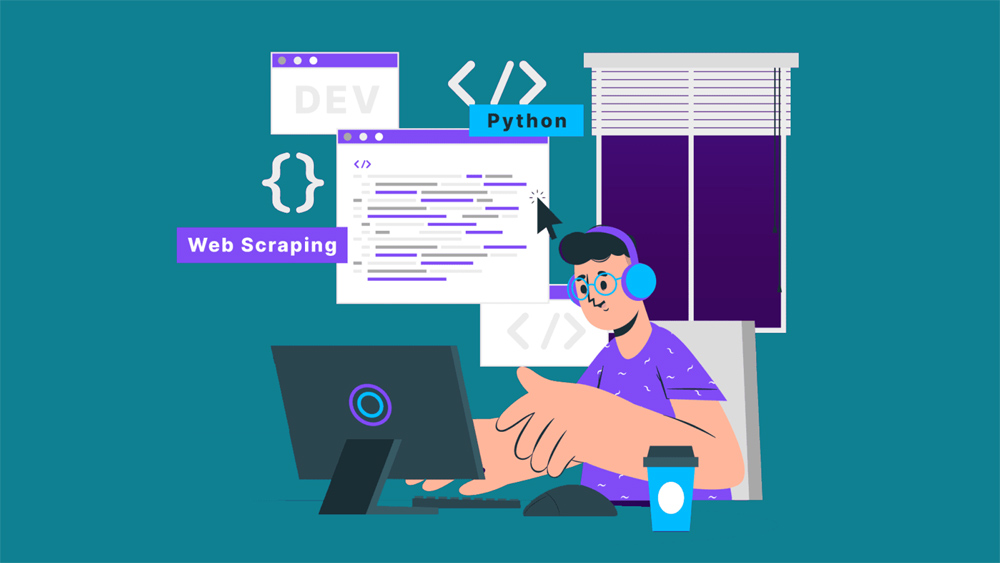
Data scraping is the process of obtaining data from a website and entering it into a spreadsheet. The technique is an effective way for a dedicated data scraper to gather plenty of data for analysis, processing, or presentation.
Web scraping is a technique for obtaining information and data from the internet (also known as data scraping). So that it can be adjusted and examined as necessary, this data is typically kept in a local file. Web scraping is a much smaller-scale version of copying and pasting content from a webpage into an Excel spreadsheet.
Read: Differences Between Artificial Intelligence (AI) and Machine Learning (ML)
Read: What is Bard AI? Google New AI Bard Chatbot?
Yet, when individuals use the term “web scrapers,” they typically refer to software applications. The purpose of web scraping software also referred to as “bots,” is to search websites, scrape the relevant pages, and then extract useful data. By automating this process, these bots can easily retrieve large volumes of data. This has clear advantages in the era of big data, which is constantly updated.
Cybersecurity and Data Scraping
Several different businesses use data scraping technologies, though not always with bad intentions. They include personalization, web content and design, and business intelligence and marketing research.
Data scraping can be used to reveal and misuse sensitive data, which presents problems for many firms. It’s possible that the website being scraped is unaware that any data is being collected about them or what is being collected. Similarly, a trustworthy data scraper might not save the information securely, giving hackers access.
Web scraping data can be used by bad actors to launch cyberattacks if they have access to it. For instance, criminals may utilize data they have scraped to carry out:
Phishing attacks: Attackers might improve their phishing strategies by using data that has been scraped. They can learn which workers have the access rights they wish to target or who is more vulnerable to phishing attacks. Attackers can launch targeted spear phishing attacks if they can discover the identities of senior staff members.
Password cracking attacks: There is always a possibility that attackers will be able to crack credentials to break through authentication protocols, even if the passwords are not leaked directly. In order to determine passwords based on personal information, they can research fully public information about your workers.
Types of Data are Available for Web Scraping
Among the most common forms of data that businesses collect are images, videos, text, product details, user opinions and reviews (found on websites like Twitter, Yelp, and TripAdvisor), and prices from price comparison websites. These are just a few examples of the types of data that businesses collect.
The Use of Web Scraping
Market research companies hire scrapers to get data from social media and internet forums for things like customer sentiment analysis. Some people scrape information from product sites such as Amazon or eBay to help with competitive analysis.
Google frequently uses web scraping to assess, rank, and index its content. With web scraping, they can also take information from other websites and transfer it to their own (for instance, they scrape e-commerce sites to populate Google Shopping).
Many such businesses also engage in contact scraping, which is the process of searching the internet for contact information to be utilized for marketing. The company you use has permission to use your contacts if you’ve allowed them access to them in exchange for using their services.
A web scraping tool can be used in a variety of ways but there are a few restrictions. It basically depends on your level of creativity and what you want to accomplish. The list is almost endless and involves everything from providing weather information to managing SEO audits.
It should be mentioned, however, that web scraping has a dark side too. In order to commit fraud, scams, intellectual property theft, and extortion, bad players frequently scrape data such as bank details or other personal information. It’s a good idea to be aware of these risks and threats before starting your own web scraping adventure. Be certain to keep updated with the law around web scraping.
Data Scraping’s Dark Side
Data scraping has numerous beneficial applications, however, a small percentage of people also misuse it.
Email harvesting is the most common misuse of data scraping; it involves collecting information from websites, social media, and directories in order to find people’s email addresses, which are then sold to spammers or con artists. It is nearly unanimously regarded as poor marketing practice to gather email addresses via automated methods, such as data scraping, with the intention of exploiting them for commercial purposes.
In order to lessen the chance that email harvesters will obtain their email address, many web users have adopted the following techniques:
Address munging is the practice of modifying the format of your email address when posting it publicly. For example, you might type “john[at]gmail.com” rather than“john@gmail.com.”This method of securing your email address on social media is simple but not totally secure because certain harvesters will look for various munged combinations in addition to emails in a normal format.
Contact forms: There are several ways you can use a contact form on your website instead of posting your email address(es) on it.
Images: Most email harvesters won’t be able to access your email address if it is displayed on your website as an image due to technological limitations.
How Does a Web Scraper Work?
We now understand what web scraping is and its various applications. The exact procedure vary based on the software or tools you’re using, but all web scraping bots stick to these three fundamental rules:
Step 1: Sending a server an HTTP request.
Step 2: Taking the website’s code, extracting and processing it.
Step 3: Local data storage.
How to Scrape the Web? (step-by-step)
Step 1: Find the URLs you wish to scrape.
Step 2: Review the page.
Step 3: Identify the data you wish to extract.
Step 4: Generate the necessary code.
Step 5: Execute the code.
Step 6: Storing the data- After collecting the relevant data and analyzing it, store it.
Tools Used to Scrap the Web
Python libraries like Beautifulsoup, Scrapy, Parsehub, and Pandas are all standard tools for scraping the web and are used frequently.
How Can Web Scraping be Entirely Stopped?
Web scraping can only be stopped completely by preventing the publication of content on a website in the first place. Websites can, however, nearly fully stop scraper bot access by using an advanced and powerful bot management tool.
Conclusion
No matter if you plan to use data scraping in your job, it is a good idea to educate yourself on the topic because it will probably become even more crucial in the coming years. If you like the post then please do share it with others.








